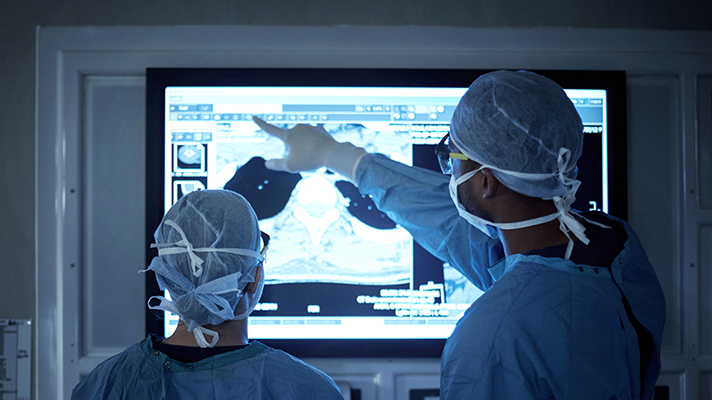
Radiology provides a perfect opportunity for machine learning (ML), a field of artificial intelligence (AI) that uses statistical techniques to give computer systems the ability to learn from data without being explicitly programmed. Since Radiology embraced digital decades before other hospital departments, data scientists are able to feed massive repositories of radiological image data into ML and Deep Learning (a subset of ML that is capable of learning unsupervised from data that is unstructured or unlabeled) algorithms.
As a consequence, the AI imaging marketplace has seen rapid expansion. Across all industries, the number of firms investing more than $500 million in AI and data analytics initiatives has increased significantly – from 12.7 percent in 2018 to 21 percent of firms in 2019, according to a survey by NewVantage Partners, a strategic advisory firm.1 NewVantage found that 92 percent of senior corporate executives (and three out of four healthcare executives) report their organizations are increasing their pace of investment in big data and AI.1 GE projects that the AI market particular to healthcare will exceed $6.5 billion by 2021, and that nearly 40 percent of healthcare decision-makers are planning to invest in machine learning and predictive analytics for imaging and other clinical applications.2
All about Infrastructure
Still, experts say the adoption of AI, ML and DL in healthcare is being impeded by a variety of IT infrastructure challenges. These challenges include siloed healthcare data, incomplete standards and privacy rules that complicate information sharing.
When talking about infrastructure preparedness, it’s important to distinguish between the two different applications for AI in healthcare settings, said Siddharth Shah, an industry analyst in the Visionary Healthcare Program at Frost & Sullivan.
“If we’re just talking about image diagnostics – answering questions like, ‘Is this image suspicious?’ – the infrastructure is already there” or can be obtained with upgraded software or hardware, Shah said. This application of AI promises to reduce manual processes, thereby addressing the profession-wide problem of radiologist fatigue. This in turn should reduce the number of interpretation errors and misdiagnoses, while keeping pace with ever-increasing volumes of radiological image studies. (According to a recent article published in the Journal of the American College of Radiology, imaging workload has grown by 26% in the last 12 years.3)
Based on a recent analysis, Frost & Sullivan found that of the 114 startups active in the AI for medical imaging space, a significant majority target image analysis. The company projects that AI in the medical imaging AI in the medical imaging industry will be a $1 billion market—or higher—by 2022.4
But assisting with image identification is just one opportunity, according to Shah. A broader definition of diagnostics, one that includes analyzing, say, a suspect image in the context of a patient’s whole medical record and population health research, is where current hospital infrastructures fall short. “In an age of precision or personalized medicine, it’s not just the test in front of you, but pulling in results and notes and other sources,” Shah said.
For this reason, Shah believes AI applications for decision support, such as helping decide the next steps in the clinical pathway for improved patient outcomes, will take longer to put into clinical practice and will trail AI apps that deliver productivity improvements.
Paul Chang, MD, professor of radiology and vice chair, radiology informatics at University of Chicago Medicine, contends the healthcare industry doesn’t have the proper IT infrastructure to feed and consume AI and deep learning data. “[Healthcare] is 10-15 years behind other industries when it comes to leveraging IT,” said Chang, who attributes this to its former, pay-for-services business model, which didn’t incentivize what he calls “differential IT strategies.”
Recommendations
In the meantime, Chang recommends focusing the IT infrastructure on data interoperability and workflow orchestration, as he and his colleagues at the University of Chicago have done over the past dozen years. “We did this 10 years ago by building a formal, service-oriented architecture with an enterprise service bus, by having a different kind of governance model and architecture model, and going beyond an EMR-centric bias,” he said.
Like Shah, Chang thinks the immediate opportunity for AI and deep learning in radiology will be “must-have” improvements in operational efficiency, not adding “a little more accuracy in diagnosing lung nodules or Alzheimer's.” For example, he cites one company that is using DL to reduce image-acquisition time by 40 to 70 percent. “It’s not sexy, it doesn’t make headlines, but what I call ‘minimally heuristic’ applications augment and improve efficiency, reduce error, reduce the variability of the workflow,” he said.
An open, machine-to-machine data architecture is needed, say Chang and others, because it’s too early, from an IT procurement perspective, to bet on one vendor or another.
But there are complications here, too. Can the healthcare organization safely adopt AI tools from multiple vendors, or will administrative overhead (integration and implementation costs) undermine the project? Does the IT organization have the necessary data science skills to deploy and manage these AI, ML and DL solutions successfully?
Regardless, healthcare organizations must start somewhere, insists Chang. “Many hospitals lack a true architectural perspective … they just buy stuff,” and expect the vendor will put it all together. That’s a mistake, he said. “They need to be in the driver’s seat, with a fundamentally different mindset, and a much more proactive governance model.”
References
- NewVantage Partners. Big Data and AI Executive Survey 2019. Executive Summary of Findings. http://newvantage.com/wp-content/uploads/2018/12/Big-Data-Executive-Survey-2019-Findings-122718.pdf?rel=0
- Tom Sullivan. “GE to show artificial intelligence apps and smart devices for precision health at HIMSS19.” Healthcare IT News. January 7, 2019. https://www.healthcareitnews.com/news/ge-show-artificial-intelligence-apps-and-smart-devices-precision-health-himss19
- Nanxi, Z., M.N. Patlass, and Diszak, Jr., R. “Radiologist Burnout Is Not Just Isolated to the United States: Perspectives From Canada.” Journal of the American College of Radiology. January 2019, V. 16, Issue 1, pp. 121-123. https://www.jacr.org/article/S1546-1440(18)30856-1/fulltext
- Michael Walter. “AI-powered image analysis ranked 2019’s top digital health technology.” February 6, 2019. Radiology Business. https://www.radiologybusiness.com/topics/healthcare-economics/ai-radiology-image-digital-health-technology



